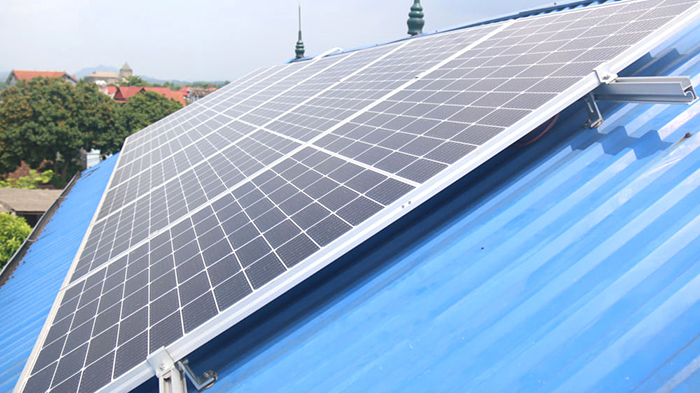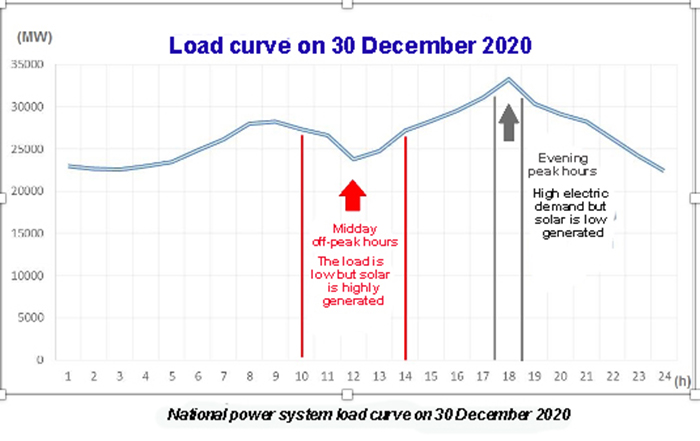Rooftop solar power boom
It can be said that in recent years, the incentive mechanism for solar power development in Vietnam (Decision No. 11/2017/QD-TTg dated 11 April 2017 and Decision No. 13/2020/ QD-TTg dated 6 April 2020 by the Prime Minister) has enabled the renewable energy boom in general and solar power in particular in Vietnam. Up to now, the total installed capacity of solar power in the country has attained about 19,400 MWp (of which nearly 9,300 MWp is of rooftop solar power), equivalent to about 16,500 MW - accounting for about 25% of the total installed capacity of the national power system.
According to statistics, the total solar power generation output in 2020 nationwide was 10.6 billion kWh (of which 1.16 billion kWh was from rooftop solar power), accounting for about 4.3% of the total electricity output of the national power system.

Illustration image
Difficulties in operating solar power systems
Although the statistics show that the total capacity of solar power represents roughly 25% of the installed capacity of the power system, given the natural feature of solar energy with high dependence on sunshine hours of the day, i.e. a large amount of electricity is generated in strong sunlight conditions, and solar power is not available when sunlight turns off, which causes difficulties and challenges in power system operation.
Due to the gradual cold trend of the weather from September to the end of the year, the load curve of the national power system shifted to the typical one in the cold season. According to the data above, if the total solar power capacity in the country is 16,500 MW, it would be equivalent to about 40% of the national load at midday off-peak time.

From the typical daily load curve recently, several characteristics of the power system operation can be seen as shown in the figure above, which are:
- The time of overcapacity is at midday off-peak hours, from 10 am to 14 pm (especially on weekends and holidays) because at this time the load is low but solar radiation is the best during the day.
- On the other hand, during peak hours in the evening (about 17:30 to 18:30) when the electricity demand is the highest in the day and the power system needs quite a large capacity, the generation capacity of dozens of thousands of megawatts of solar power are almost gone. Therefore, to ensure power supply, the power system always needs to maintain a number of conventional power plants in ready status.
Besides changes in load at different times of the day, the load demand between weekdays and weekends also has a large difference. In which, the difference between peak capacity of weekends and weekdays is up to about 5000 MW, so on weekends, the National Load Dispatch Center has to stop running many thermal power units (coal-fired) and gas turbines as backup power sources as long as the minimum number of grid-connected power units are on line to meet the technical conditions of the system (availability assurance, voltage mode, transmission limit, etc.).
It can be seen that the proportion of renewable energy sources in the power system is increasing and there is a corresponding increase in operational instability, plus many adverse objective reasons such as: (i) Lower than expected load growth due to effects of the COVID-19 pandemic; (ii) A very large difference between peak and off-peak load during the day; (iii) Peak load in the afternoon is large while solar energy is unavailable, leading to many difficulties in dispatching the power system.
In order to ensure security and safety in the operation of the power system, the National Load Dispatch Center cannot dispatch the full available capacity of power plants, including renewable energy sources such as wind power and solar power at midday off-peak hours, weekends or public holidays like New Year holidays and Lunar New Year 2021.
The dispatch and mobilization of power plants in the system has been and is being carried out through the AGC (Automatic Generation Control) system, which automatically adjusts to increase or decrease power generation capacity in order to maintain the stable operation of the entire power system. This system will automatically monitor and optimize the adjustment of generating capacity of power plants, including renewable energy stations on a real-time basis, ensuring openness and transparency in the dispatching of the national power system.
CONTACT INFORMATION:
Communications Department - Vietnam Electricity;
Email: bantt@evn.com.vn
Phone: 024.66946405 / 66946413;
Fax: 024.66946402
Address: No. 11 Cua Bac Street, Truc Bach Ward, Ba Dinh District - Hanoi;
Website: www.evn.com.vn, www.tietkiemnangluong.vn
Fanpage: www.facebook.com/evndienlucvietnam
evn.com.vn
Share